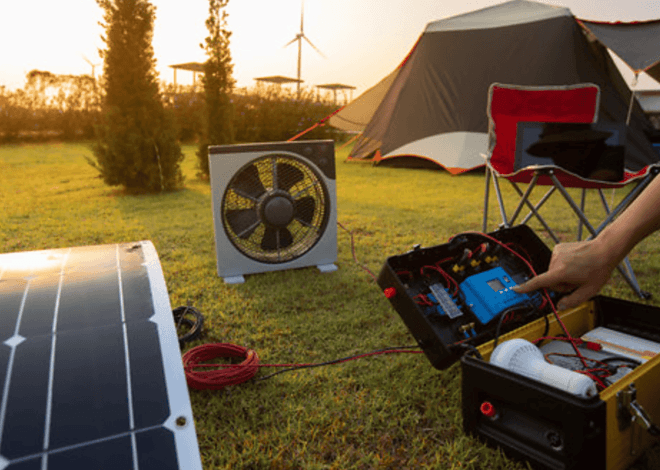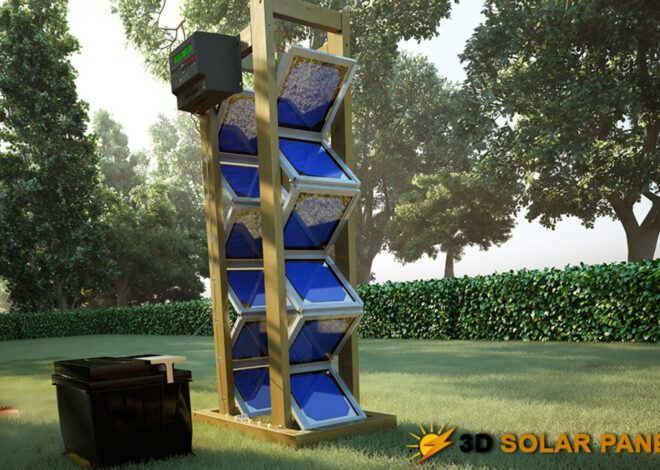
How To Build A Solar Powered Generator
Welcome to the ultimate guide on how to build a solar powered generator. Imagine harnessing the sun’s energy to power your devices, whether it’s during a camping trip or in the middle of an unexpected blackout. Solar powered generators are not just a trend; they’re a practical solution for those looking to embrace renewable energy.
These systems offer independence and sustainability, allowing you to generate electricity without relying on traditional fuel sources. Building your own solar generator can seem daunting at first. However, with the right guidance and materials, it becomes an exciting project that anyone can tackle.
The benefits go beyond convenience; you’ll be contributing to a cleaner planet while saving money on energy costs over time. Curious about how to get started? Let’s dive into the world of solar powered generators and explore everything from their advantages to step-by-step instructions for building one yourself!
Benefits of Using a Solar Powered Generator
Solar powered generators offer numerous advantages that appeal to eco-conscious individuals. For starters, they harness renewable energy from the sun, reducing reliance on fossil fuels. Cost savings are another major benefit. Once installed, sunlight is free.
This means lower electricity bills and minimal maintenance costs over time. Moreover, these generators provide a reliable power source during outages or emergencies. They can keep essential devices running when conventional sources fail. The portability of compact solar generators makes them ideal for camping trips or outdoor activities.
You can enjoy off-grid adventures without sacrificing comfort. Additionally, using solar energy contributes to a cleaner environment by lowering carbon emissions. Investing in a solar generator not only benefits your household but also supports global sustainability efforts.
Types of Solar Panels for a Generator
When considering how to build a solar powered generator, selecting the right type of solar panel is crucial. There are three main types: monocrystalline, polycrystalline, and thin-film. Monocrystalline panels are known for their high efficiency and long lifespan.
They’re made from pure silicon crystals and perform exceptionally well in low-light conditions. This means they can generate more power in less space. Polycrystalline panels are slightly less efficient but often come at a lower cost. Their blue hue distinguishes them from monocrystalline options.
They work best in sunny environments where space isn’t an issue. Thin-film panels offer flexibility and lightweight design but have lower efficiency compared to the other two types. These can be ideal if you need portability or plan to use your generator in various locations.
Each type has its advantages based on your specific needs for power output, budget, and available installation area.
Materials and Tools Needed for Construction
To embark on your solar powered generator project, gathering the right materials is crucial. You’ll need solar panels to harness sunlight efficiently. Aim for at least 100 watts of capacity, depending on your power needs. Next up are batteries.
Deep-cycle lead-acid or lithium-ion types work best for energy storage. They ensure you have a reliable power reserve when the sun isn’t shining. An inverter is also essential; it converts DC power from the batteries into AC power for your devices.
Look for an inverter that matches or exceeds your wattage requirements. Don’t forget wiring and connectors to safely link all components together. Heavy-duty cables can handle higher loads without overheating.
Tools like a multimeter will help you troubleshoot electrical connections, while basic hand tools make assembly easier. With these materials in hand, you’re ready to start building!
Step-by-Step Guide on Building a Solar Powered Generator
Solar-powered generators are a fantastic way to harness renewable energy. They provide power for outdoor adventures, emergency backup, or everyday use. Building one yourself can be both rewarding and cost-effective.
Before diving into the project, it’s important to understand the basics of solar technology. Familiarize yourself with how solar panels convert sunlight into electricity. Knowledge is key when embarking on your DIY journey.
Gathering materials comes next. You’ll need solar panels, batteries, an inverter, and various connectors. Each component plays a crucial role in ensuring that your generator functions smoothly.
As you assemble everything step by step, remember to follow safety precautions at all times. Proper connections will enhance efficiency and reliability.
Testing your system is essential too! A few tweaks might be necessary during this phase to ensure optimal performance before putting it into action in real-world scenarios.
Step 1: Designing Your Solar Powered Generator
Designing your solar powered generator is an exciting first step. Start by determining your power needs. Consider what devices you want to run and their energy consumption. This will help guide the size of your system.
Next, think about the configuration. Will it be portable or stationary? Sketch out a rough layout to visualize where each component will fit together.
Choosing the right solar panel type is crucial too—monocrystalline panels are efficient but more costly, while polycrystalline options may be budget-friendly with slightly less efficiency.
Plan for airflow and cooling in your design. Adequate ventilation prevents overheating and ensures long-lasting performance for all components involved in generating that clean energy!
Step 2: Gathering the Necessary Components
Now that you have a design in mind, it’s time to gather the necessary components for your solar powered generator. This step is crucial for ensuring everything works seamlessly together.
Start with the solar panels. Depending on your power needs, choose panels that are efficient and suitable for your setup. Look for high-quality options that offer good warranties.
Next, you’ll need batteries. Deep cycle batteries are ideal because they can handle repeated charging and discharging cycles without losing capacity too quickly.
Don’t forget the inverter! This device converts the DC electricity generated by the solar panels into AC electricity for household use. Choose one that’s compatible with both your battery system and energy requirements.
Collect necessary wiring, connectors, and mounting brackets to complete your collection of parts. Having all these elements ready will make assembly much smoother later on.
Step 3: Assembling the Solar Panels
Assembling your solar panels is an exciting part of building a solar powered generator. Begin by laying out all the components in an organized manner. This includes the solar cells, glass sheet, and backing material.
Start with the glass sheet as it will provide protection for the delicate solar cells. Carefully place the cells on top of this sheet. Make sure they are aligned properly to maximize sunlight exposure.
Next, use adhesive or soldering techniques to secure each cell in position. Ensure that connections between them are tight and effective for optimal energy flow.
Once secured, add a backing layer to shield from moisture and physical damage. It’s crucial that everything is watertight; any leaks can compromise efficiency over time.
Double-check all connections before moving forward. Proper assembly now sets you up for success during later stages of your project.
Step 4: Connecting the Batteries and Inverter
Now that your solar panels are securely assembled, it’s time to focus on the heart of your solar-powered generator: the batteries and inverter. These components work together to store energy and convert it into usable power.
Start by placing your deep-cycle batteries in a well-ventilated area. Ensure they’re mounted securely to prevent any movement during operation. Connect the positive terminal of one battery to the negative terminal of another if you are using multiple batteries for greater capacity.
Next, attach wires from each battery’s remaining terminals to your inverter’s input connections. The inverter transforms direct current (DC) from the batteries into alternating current (AC), making it suitable for household appliances.
Double-check all connections for tightness and correct placement. Safety is crucial here, so wearing gloves can protect you from potential shocks while ensuring everything is properly secured before moving forward with testing.
Step 5: Testing and Troubleshooting
Testing your solar powered generator is a critical step to ensure everything functions as intended. Start by checking all connections. Loose wires can lead to inefficiencies or even failures.
Once you’re confident the assembly is secure, power up the system. Use a multimeter to measure voltage output from the solar panels and batteries. This will help you identify any discrepancies in performance.
If something isn’t working right, troubleshoot systematically. Check each component: are the panels clean? Is there adequate sunlight?
Battery health plays a vital role too; verify their charge levels regularly. If issues persist, consult manuals for specific components or seek advice from online forums where enthusiasts share solutions.
Keep notes of what works and what doesn’t during testing. This documentation will be invaluable for future repairs and optimizations, making it easier to maintain your generator’s efficiency over time.
Maintenance and Upkeep of a Solar Powered Generator
Maintaining a solar powered generator is crucial for longevity and efficiency. Regular inspections can help identify potential issues early on. Start by cleaning the solar panels. Dust, dirt, or debris can hinder their performance. A simple wash with mild soap and water keeps them functioning optimally.
Check the battery regularly too. Ensure it’s charged correctly and free from corrosion. Inspect connections for tightness to avoid power loss. Keep an eye on inverter functionality as well. This component converts DC power into AC, making it essential for household use.
Monitor usage patterns to understand when maintenance might be necessary. Keeping a log of your generator’s performance helps spot trends that require attention over time.
Alternative Energy Sources for Backup Power
When considering backup power, solar energy isn’t the only option. Wind turbines can harness breezes to generate electricity. A small wind generator can be a fantastic addition for areas with consistent winds. Hydroelectric systems are another alternative.
Even a modest setup using flowing water can produce reliable power. This method is especially useful near rivers or streams. Biomass energy is interesting too. Organic materials like wood chips or agricultural waste can be converted into electricity through combustion or gasification processes.
Don’t overlook battery storage alongside these sources. Combining different setups enhances reliability and ensures you’re ready for unexpected outages. Every alternative brings unique benefits and challenges, making it essential to assess which combination suits your needs best.
Embracing diverse solutions paves the way for sustainable living while minimizing dependence on traditional grid systems.
Conclusion
Building a solar-powered generator is an excellent way to harness renewable energy for your power needs. With the right materials and knowledge, you can create a reliable source of clean energy that benefits both your lifestyle and the environment.
By understanding the various types of solar panels available, you can choose what best fits your project. Each type has its unique advantages, making it essential to match them with your specific requirements.
The step-by-step guide provided gives you a clear pathway to assembling your own generator. Whether you’re looking for emergency backup power or simply want to reduce electricity costs, this DIY project offers practical solutions while enhancing self-sufficiency.
Maintaining your solar-powered generator ensures it operates efficiently over time. Regular checks and upkeep will keep everything running smoothly so that when you need power most, it’s there for you. Considering alternative energy sources adds another layer of resilience to your setup.
Exploring options like wind or hydroelectric systems could provide additional backup solutions in times of need. Embracing renewable energy through building a solar-powered generator opens doors to sustainable living. It’s not just about saving money; it’s about contributing positively towards our planet’s future too.




Jack,
Hi there! I really enjoyed your article on building a solar-powered generator. The step-by-step instructions you provided make it feel achievable for anyone interested in sustainable energy. I had a small solar panel setup in the past, and while it worked okay, I now realize that I wasn’t using the correct size inverter. If I had done that, my system would have been so much more efficient!
I especially appreciated your insights on choosing the right battery and understanding the components involved. It’s fascinating how each part plays a critical role in maximizing energy output. Your tips on troubleshooting common issues will be invaluable as I work on my own setup. Thank you for sharing such valuable information—I’m excited to try building my own generator with the tips you’ve provided!
Best,
Opa
Hi Opa,
I’m so glad that you enjoyed our step-by-step guide on how to build a solar powered generator. I did a lot of researched before writing this guide and learned a whole lot about solar powered generators. They are easier to build than I thought. You do have to mechanically inclined because it makes for an easier build.
I have not tried to build one of these solar generators yet because I already own one that cost me $3,000. It works great and you can use it in your house without the fear of carbon monoxide poisoning. I can power my refrigerator and freezer along with some of my household appliances.
It is probably cheaper to build your solar powered generator so I’m very interested to hear how your project turns out and what it cost for materials. So please comeback and share your experience with us. Thank you for stopping by today and sharing your thoughts with us today. Good luck with your build!
Best wishes Opa,